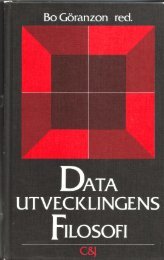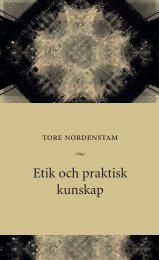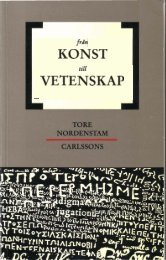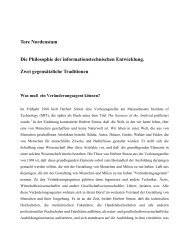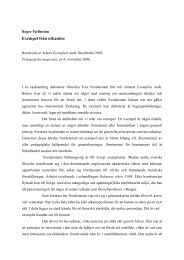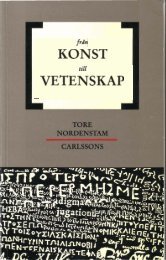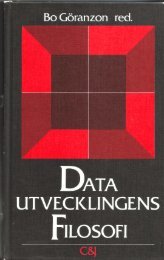tore nordenstam explanation and understanding in the history of art
tore nordenstam explanation and understanding in the history of art
tore nordenstam explanation and understanding in the history of art
You also want an ePaper? Increase the reach of your titles
YUMPU automatically turns print PDFs into web optimized ePapers that Google loves.
p<strong>art</strong>icularly for expla<strong>in</strong><strong>in</strong>g actions <strong>in</strong> a social sett<strong>in</strong>g.” 50 The claim is now that <strong>the</strong><br />
<strong>in</strong>tentionalist pattern is “pivotal <strong>in</strong> <strong>the</strong> sense that <strong>the</strong> o<strong>the</strong>r explanatory mechanisms all<br />
seem to revolve round this schema as <strong>the</strong>ir core.” 51<br />
The claim that <strong>the</strong> <strong>in</strong>tentionalist pattern hits upon someth<strong>in</strong>g which is essential to<br />
<strong>explanation</strong>s. <strong>in</strong> <strong>the</strong> human sciences seams immediately conv<strong>in</strong>c<strong>in</strong>g e,g, <strong>in</strong> <strong>the</strong> light <strong>of</strong> <strong>the</strong><br />
examples collected <strong>in</strong> <strong>the</strong> beg<strong>in</strong>n<strong>in</strong>g <strong>of</strong> this chapter. Example 6, for <strong>in</strong>stance, seems tailor-<br />
made to illustrate <strong>the</strong> <strong>in</strong>tentionaliat pattern <strong>in</strong> <strong>the</strong> prelim<strong>in</strong>ary version quoted at <strong>the</strong> top <strong>of</strong><br />
<strong>the</strong> forego<strong>in</strong>g page. With little reformulation, it can be fitted <strong>in</strong>to <strong>the</strong> schema:<br />
Mondrian <strong>in</strong>tended to br<strong>in</strong>g about <strong>the</strong> autonomy <strong>of</strong> pa<strong>in</strong>t<strong>in</strong>g.<br />
Mondrian considered that he could not br<strong>in</strong>g about <strong>the</strong> autonomy <strong>of</strong> pa<strong>in</strong>t<strong>in</strong>g<br />
unless he dispensed with any suggestion <strong>of</strong> an illusory treatment <strong>of</strong> space etc.<br />
Therefore Mondrian set himself to do so.<br />
Example 4 <strong>and</strong> Example 5 can also be fitted <strong>in</strong>to <strong>the</strong> schema without any obvious<br />
difficulties. Von Wright’s schema dem<strong>and</strong>s that <strong>the</strong> actor consider <strong>the</strong> means necessary to<br />
br<strong>in</strong>g about <strong>the</strong> desired aim, which might seem to be a too str<strong>in</strong>gent condition. In Dray’s<br />
version, <strong>the</strong> dem<strong>and</strong> is <strong>the</strong> looser one that <strong>the</strong> actor should consider <strong>the</strong> chosen means to<br />
be adequate for reach<strong>in</strong>g <strong>the</strong> aim. The difference between von Wright’s <strong>and</strong> Dray’s<br />
versions is, however, only apparent. For “what is necessary is usually not that just one<br />
def<strong>in</strong>ite action be performed, but that one out <strong>of</strong> several is chosen. The practical necessity<br />
is <strong>the</strong>n a disjunctive action.” 52 With this proviso, von Wright’s schema would seem to<br />
clarify one type <strong>of</strong> <strong>explanation</strong> that is common also <strong>in</strong> <strong>the</strong> <strong>history</strong> <strong>of</strong> <strong>art</strong>. In order to cover<br />
<strong>the</strong> <strong>art</strong>-historical material, <strong>the</strong> basic schema will, however, have to be elaborated <strong>in</strong><br />
various ways. The <strong>in</strong>terplay between aims <strong>and</strong> means <strong>in</strong> creative activities will have to be<br />
considered, <strong>and</strong> <strong>the</strong> nature <strong>of</strong> <strong>the</strong> k<strong>in</strong>d <strong>of</strong> <strong>in</strong>tentions that are relevant <strong>in</strong> <strong>art</strong>-historical<br />
contexts will have to be clarified. To this we shall return <strong>in</strong> <strong>the</strong> last chapter <strong>of</strong> this essay.<br />
50<br />
G. H. von Wright, ”Replies”, <strong>in</strong> J. Mann<strong>in</strong>en <strong>and</strong> R. Tuomela, eds., Essays on Explanation <strong>and</strong><br />
Underst<strong>and</strong><strong>in</strong>g. Studies <strong>in</strong> <strong>the</strong> Foundations <strong>of</strong> <strong>the</strong> Humanities <strong>and</strong> Social Sciences, Syn<strong>the</strong>se Library, Vol.<br />
72, D. Reidel Publish<strong>in</strong>g Company, Dordrecht 1976, p. 413. Cf. pp. 374, 394-395.<br />
51<br />
von Wright, ”Replies”, p. 413. Cf. p. 394.<br />
52<br />
Op. cit., p. 396. Cf. p. 418.






